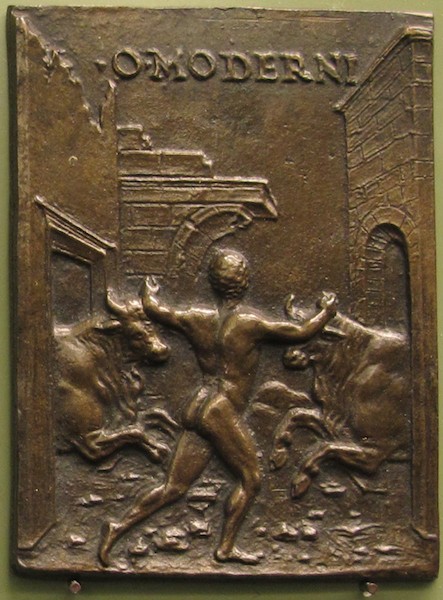
A plate signed by “Moderno,” an artist of interest to Robert’s future research
In the summer of 2013 I had the pleasure of participating in the “Translating the Past” workshop at ISI Florence, attending seminars on palaeography, codicology, and philology with Professors Antonella Ghignoli, David Rundle, and Paul Gwyne. The skills and experience I acquired on the course fundamentally changed the way I do research. Not only did I gain access to a vast array of unpublished manuscripts and early printed books that I never could have deciphered without formal training. I also learned to look at familiar modern editions of primary sources with new eyes, attuned to the rich, multifaceted layers of evidence and interpretation on which they are based.
The benefits to my own research were immediate. For my final project I studied a manuscript of Alberti’s De pictura at the Biblioteca Nazionale, learning much from its fifteenth-century annotations, as well as from its unique codicological characteristics. Having received warm introductions to the Biblioteca Laurenziana, the Biblioteca Riccardiana, and the Archivio di Stato during the workshop, I was able to complete a good deal of primary research toward my dissertation in the weeks following, all the while benefiting from the continuing support of my contacts at ISI Florence.
In the ensuing years that support has only continued to grow and flourish, as my ISI professors have both introduced me to a wide network of leading scholars in the field, and helped me pursue publications, grants, and fellowships. Most recently Prof. Stefano Baldassarri, ISI Florence Director, generously supported my successful application for a postdoctoral fellowship at the Kunsthistorisches Institut in Florenz (Max-Planck-Institut), where I plan to expand my dissertation research on late medieval and Renaissance conceptions of painting as a “modern art” (ars moderna). Thanks in large part to the skills, experience, and contacts I gained at ISI Florence, I will return to research in Florence fully prepared to hit the ground running.
Robert Brennan, Institute of Fine Arts, New York University
